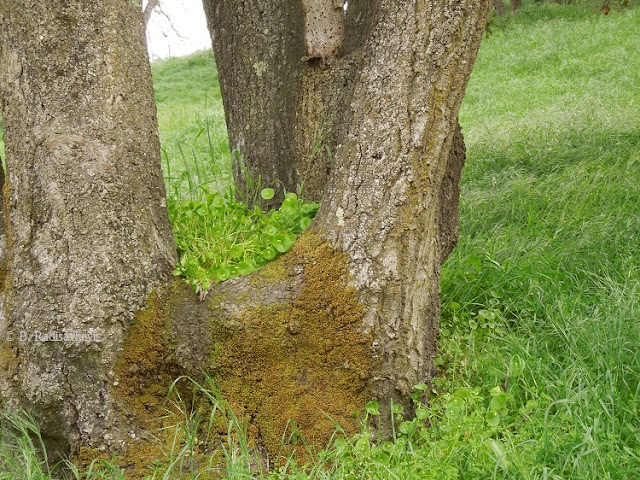The best place to find miner's lettuce on the Central Coast is in partial shade in a moist place. After finding it that first time, I didn't encounter it again until last year. I was exploring a back road in March and found it under and actually on a tree just off South Vine Street.
 |
| Miner's Lettuce Growing on and under a Tree, © B. Radisavljevic |
On that day I did pick some. When I got home, I made a salad with some other greens I had, and it was tasty. Use it as you would any other lettuce.
Miner's lettuce got its name because miners used to eat it for its vitamin C content to prevent scurvy. Native Americans ate it raw or cooked, and made a tea of it to use as a laxative. The flavor of young miner's lettuce leaves is mild, unlike its cousin purslane, another edible weed that appears almost everywhere in my garden during the summer. You can find out more about purslane here. Older leaves of miner's lettuce can be cooked as you would cook spinach.
A few weeks ago while I was out walking I saw some miner's lettuce just outside my back neighbor's fence, along the street, in an uncultivated spot. It was growing with other weeds, and I think one of them was chickweed, also edible, that I have not learned to positively identify yet.
I know miner's lettuce and chickweed do often grow near each other, since they have the same requirements -- shade and moisture. I picked a lot of miner's lettuce and had a splendid salad that day. While lettuce in the market was sky high in price, I used free miners lettuce mixed with other wild edible plants growing in my own yard. Why go buy lettuce when miner's lettuce is tasty and free?
 |
| Miner's Lettuce Growing Near My Home © B. Radisavljevic |
If you'd like to feast free on wild foods growing near you, one of the books below will help you stay safe by showing you how to identify free food and avoid anything toxic. I personally own and use Feasting Free on Wild Edibles, but want to add some of the other books with color photos, such as the Field Guide to Edible Wild Plants by the same author.
Field Guide to Edible Wild Plants Feasting Free on Wild Edibles
Feasting Free on Wild Edibles California Foraging: 120 Wild and Flavorful Edibles from Evergreen Huckleberries to Wild Ginger
California Foraging: 120 Wild and Flavorful Edibles from Evergreen Huckleberries to Wild Ginger Adventures in Edible Plant Foraging: Finding, Identifying, Harvesting, and Preparing Native and Invasive Wild Plants
Adventures in Edible Plant Foraging: Finding, Identifying, Harvesting, and Preparing Native and Invasive Wild Plants
 Feasting Free on Wild Edibles
Feasting Free on Wild Edibles California Foraging: 120 Wild and Flavorful Edibles from Evergreen Huckleberries to Wild Ginger
California Foraging: 120 Wild and Flavorful Edibles from Evergreen Huckleberries to Wild Ginger Adventures in Edible Plant Foraging: Finding, Identifying, Harvesting, and Preparing Native and Invasive Wild Plants
Adventures in Edible Plant Foraging: Finding, Identifying, Harvesting, and Preparing Native and Invasive Wild Plants
&
If you enjoyed this post, please share it. The sharing buttons are just above the comment box at the end of this post. The photo below is especially designed for pinning.
A is for Apple Blossoms
B is for Bottlebrush
C is for Carnations
D is for Daisy
E is for Elderberry
F is for Flowers
G is for Gazania
Hollyhocks are Edible
Irises Are Garden Survivors
Jupiter's Beard: A Mystery Finally Solved
Kale for Lunch





1 comment:
Interesting to know the many things for free that we can forage. This is what one Vietnamese colleague told me once but I don't recognise the plants. The pictures here introduced me miner's lettuce so I'll be on the look out for some.
Post a Comment